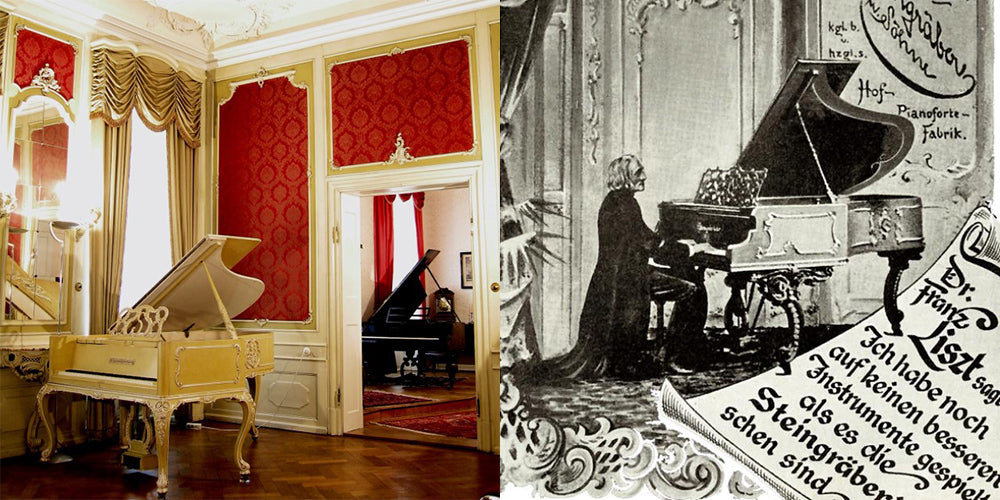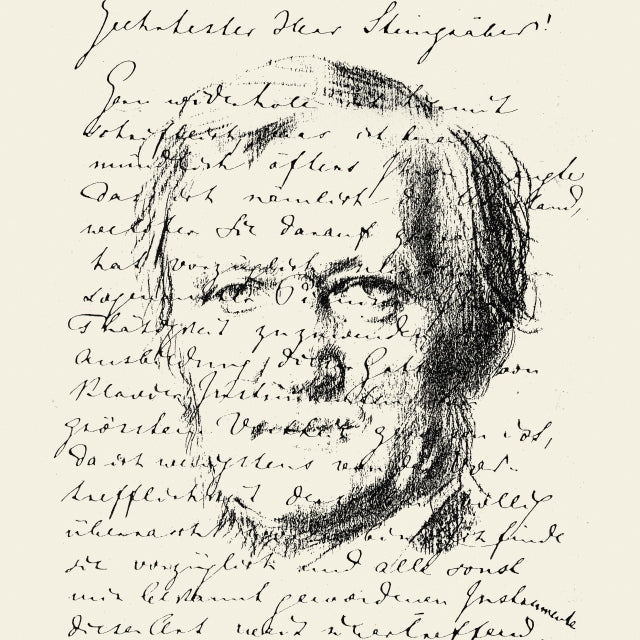Collection: Steingraeber & Söhne Piano History

The Art of Piano Making in Bayreuth since 1852
Steingraeber & Söhne have been making upright and grand pianos since 1852 in the Festival City of Bayreuth. Around 35 first-class craftsmen and women work daily in this family-run business.
These hand-crafted pianos are among the finest instruments produced by an elite group of manufacturers. Steingraeber pianos are played worldwide by an array of distinguished artists and in the most-renowned concert halls.
The story begins in the 1820’s with the first factory in Thuringia. Eduard Steingraeber (from the family’s second generation) moved his works to Bayreuth in 1852, where he produced his ‘Opus 1,’ a revolutionary masterpiece. Steingraeber pianos have regularly been awarded international prizes since 1867, and in 1906, world-famous designers began to fashion piano cabinets for Steingraeber.

Udo Schmidt-Steingraeber, a sixth-generation family member, has been head of the firm since 1980, with the seventh generation already in the starting blocks.

Three generations with dog: Gathered around Magdalene, the most-senior member of the family, are her grandchildren, Fanny and Alban, as well as the current heads of Steingraeber & Söhne, Cordelia and Udo Schmidt-Steingraeber. In this photo, taken in January 2014 on the occasion of our senior partner’s 97th birthday, you will see the Steingraeber ‘Liszt grand piano’ in the foreground and the founder’s ‘Opus 1’ masterpiece in the background.
Not only has the family tradition remained strong; so have recognition through international accolades, the company’s historic residence and, above all, the benevolence of distinguished artists worldwide. Steingraeber & Söhne also remains a leader at the cutting edge of new developments in the construction of world-class instruments.

Then as now, Steingraeber has been a leader of new developments in the construction of our world-class instruments. Occasionally new innovations will draw upon earlier playing features, such as the Mozart Rail® which reduces the key depth in grand pianos from 10 to 8mm, or the Sordino®, a thin strip of felt inserted between the hammers and strings creating a sound which Franz Schubert called for with his “fp” dynamic.
In tandem with the family history, the head office also remains located in Bayreuth’s Friedrichstraße, and Steingraeber Haus is one of the few buildings in the rococo style to have been preserved largely in its original form. The Margravial Camerier v. Liebhardt erected the splendid palace in 1754, which Eduard Steingraeber subsequently bought in 1871 and turned it into the artistic expression of the successful piano manufacturer you see today.
Thus the ‘Rococo Hall’ – it has been preserved in its original form to this day – was endowed with an appropriate grand piano, today know as the ‘Liszt Grand Piano’. For Franz Liszt was a frequent guest in the Steingraeber Haus, where he would play the piano and meet with friends. The suite on the ground floor was perfectly suited to the presentation of pianos, as it is still today, while the former servants’ house now functions as a wing to Steingraeber Haus, with three halls dedicated to the selection of pianos.
Visitors can get to know the workshop spaces in the neighbouring building during regular factory tours. In addition, around seventy events take place each year, featuring renowned artists and aspiring master pianists in the so-called Chamber Music Hall.
World Heritage
Franz Liszt and Eduard Steingraeber

It is unquestionable that the most important piano virtuoso of the 19th century was Franz Liszt (1811-1886), who always gave dazzling performances using his technical abilities. Liszt alone had the courage to do something we take for granted today: In 1839, he gave the first public solo piano recital in Europe.
The connection between Franz Liszt and Eduard Steingraeber began in 1846, when the latter as a young man worked at the famous piano manufacturer Nannette Streicher in Vienna. Liszt contacted Steingraeber, who then became Liszt’s own concert technician. If Liszt’s grand piano developed a fault during a concert, it was Eduard Steingraeber who would have to fix the instrument in front of both Liszt and the audience in order to ensure the continuation of the concert. After Eduard Steingraeber passed his master craftsman’s examination in 1852, he founded the pianoforte manufacturer ‘Steingraeber’ in Bayreuth. It provided grand pianos for Liszt, who had great influence upon the special qualities related to both the construction and tonal richness of every Steingraeber & Söhne grand piano. It was surely Liszt who prompted Eduard and George Steingraeber to create new soundscapes, which still sound incredibly modern today. Many world-class pianists, such as Daniel Barenboim, appreciate the unique sound of a Steingraeber instrument.
Today there are still traces of Liszt in Bayreuth, for example the Liszt Museum, a little mausoleum and, of course, Steingraeber Haus itself. He would often play in the Rokokosaal (Rococo Room), where the original ‘Liszt grand piano’ dated 1873 still stands. There, he would play together with friends and colleagues, and would hold public recitals. Today, concerts are still played on the Liszt grand piano. In July 1886, the Steingraeber supplied Franz Liszt with a grand piano model 205 (known today as the C-212), production no. 4328, Liszt’s last Steingraeber instrument, which you can also see in Steingraeber Haus. This instrument served as a template for the construction of current special grand piano model ‘C-212 Liszt’.
Interesting fact: The stave you can see in the Steingraeber logo is taken from Franz Liszt’s ‘Bagatelle sans tonalité’ from 1885. Steingraeber & Söhne donated the restored manuscript to the Weimar Classics Foundation.
Richard Wagner and Eduard Steingraeber

In his autobiography ‘Mein Leben’ (My Life), Wagner recalled his very first visit to Bayreuth in the summer of 1835, when traveling by stagecoach from Prague to Nuremberg. He must surely have visited the Baroque town centre back then, and in 1864 read ‘Siebenkäs’ by Jean Paul. Subsequently in late 1870, when looking for a place to house his life’s work (which however was under the jurisdiction of his patron, King Ludwig II of Bavaria) he chanced to read about Bayreuth’s Markgravial Opera House, famed for the size of its stage. Even though it proved to be unsuitable for Wagner’s plans, the decision in favour of Bayreuth was made upon his very first visit there with Cosima on 1 February 1871. One year later, sites for both the new Festspielhaus and the Villa Wahnfried had been chosen.
As far back as spring 1879, Wagner asked Eduard Steingraeber if it would be possible to produce the four pitches of the ringing bells in ‘Parsifal’ (C, G, A, and E in the lower bass register) on a piano-like instrument with large hammers and wide keys. Steingraeber drew up plans for an instrument consisting of a tall, narrow case in the shape of a piano. At 220 centimetres, the extraordinarily long strings would be struck by four, 8cm-wide hammers, and the keys themselves would be 7cm wide. In August 1881, Wagner gave Steingraeber the contract to start manufacture.
Sorry, there are no products in this collection
